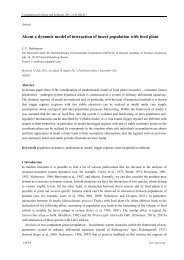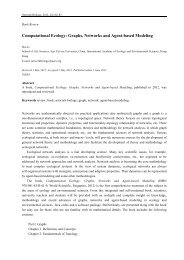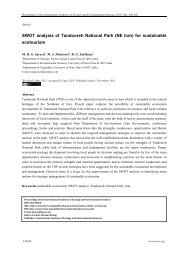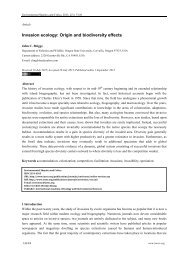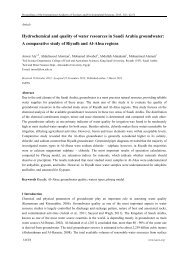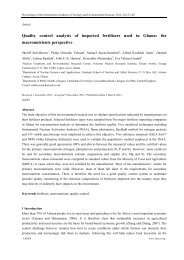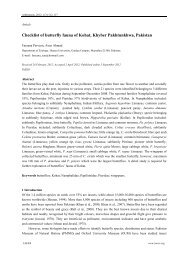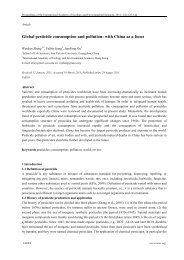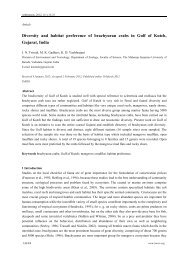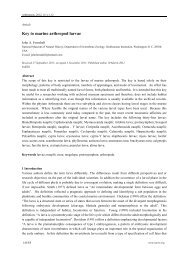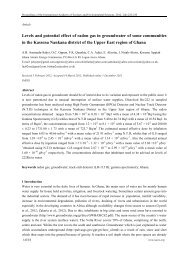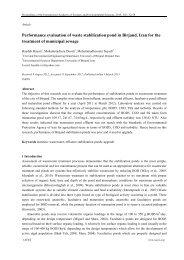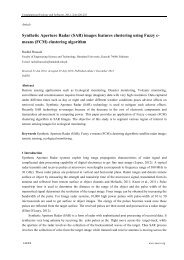Measuring competition in plant communities where it is difficult to ...
Measuring competition in plant communities where it is difficult to ...
Measuring competition in plant communities where it is difficult to ...
Create successful ePaper yourself
Turn your PDF publications into a flip-book with our unique Google optimized e-Paper software.
Computational Ecology and Software, 2011, 1(3):125-137<br />
133<br />
( p)<br />
( o)<br />
2<br />
p(<br />
X <br />
| X , z(<br />
y),<br />
θ,<br />
σ )<br />
(7)<br />
t1,<br />
y n t1,<br />
y<br />
S<br />
<strong>where</strong><br />
( p)<br />
X and<br />
(o)<br />
X<br />
are the predicted and observed covers of the <strong>in</strong>vestigated species, respectively, θ <strong>is</strong><br />
location parameters <strong>in</strong> the two process equations for the <strong>in</strong>vestigated species, and<br />
2<br />
σ<br />
S<br />
<strong>is</strong> the estimated process<br />
variation <strong>in</strong> the two processes for the <strong>in</strong>vestigated species. Us<strong>in</strong>g the cond<strong>it</strong>ional relationship (9), the effects of<br />
different levels of the environmental gradient on the future cover of the studied species may be predicted and<br />
the uncerta<strong>in</strong>ty of the predictions may be quantified. For example, <strong>it</strong> may be predicted how the cover of<br />
different <strong>plant</strong> species changes over time as a function of a change <strong>in</strong> the environmental gradient z.<br />
6 Accompany<strong>in</strong>g Software: P<strong>in</strong>-po<strong>in</strong>t-calc<br />
In an accompany<strong>in</strong>g Mathematica notebook (Wolfram, 2009) called “p<strong>in</strong>-po<strong>in</strong>t-calc”, which may be<br />
downloaded from the authors homepage, there <strong>is</strong> a simple example of simulated cover and vertical dens<strong>it</strong>y data<br />
of two compet<strong>in</strong>g species along an environmental gradient. The <strong>compet<strong>it</strong>ion</strong> data <strong>is</strong> both generated and<br />
analysed accord<strong>in</strong>g <strong>to</strong> the above described state-space model.<br />
The notebook <strong>is</strong> a demonstration of the application of the model, but <strong>it</strong> may also be used <strong>to</strong>: i) illustrate the<br />
functional relationships <strong>in</strong> the model, ii) generate new cover and vertical dens<strong>it</strong>y data of two compet<strong>in</strong>g species<br />
along an environmental gradient, and iii) estimate model parameters of cover and vertical dens<strong>it</strong>y data of two<br />
compet<strong>in</strong>g species along an environmental gradient us<strong>in</strong>g spreadsheet data. Thus, the notebook may be used as<br />
a help <strong>in</strong> the experimental dimension<strong>in</strong>g of ecological studies by generat<strong>in</strong>g data that mimic a specific<br />
ecological system, as well as <strong>in</strong> the analys<strong>is</strong> of observed <strong>compet<strong>it</strong>ion</strong> data.<br />
7 D<strong>is</strong>cussion<br />
The presented method for measur<strong>in</strong>g <strong>compet<strong>it</strong>ion</strong> <strong>in</strong> und<strong>is</strong>turbed natural <strong>plant</strong> <strong>commun<strong>it</strong>ies</strong> allows direct<br />
measurements of the compet<strong>it</strong>ive effects of neighbour<strong>in</strong>g <strong>plant</strong>s on <strong>plant</strong> performance and the estimation of<br />
parameters that describe the ecological processes of <strong>plant</strong>-<strong>plant</strong> <strong>in</strong>teractions dur<strong>in</strong>g the grow<strong>in</strong>g season as well<br />
as the process of survival and recru<strong>it</strong>ment between grow<strong>in</strong>g seasons. The advantage of part<strong>it</strong>ion<strong>in</strong>g observed<br />
changes <strong>in</strong> <strong>plant</strong> abundance <strong>in</strong><strong>to</strong> processes that take place dur<strong>in</strong>g different times of the season has previously<br />
been d<strong>is</strong>cussed by Farrer et al. (2010), who found <strong>in</strong>dications of time-lagged dens<strong>it</strong>y dependencies and<br />
advocated the use of models that use two annual measurements of abundance for d<strong>is</strong>cover<strong>in</strong>g facil<strong>it</strong>ation<br />
among <strong>plant</strong>s <strong>in</strong> a grassland commun<strong>it</strong>y. Add<strong>it</strong>ionally, the presented method <strong>is</strong> su<strong>it</strong>ed for test<strong>in</strong>g different<br />
ecological hypotheses on compet<strong>it</strong>ive <strong>in</strong>teraction along environmental gradients, <strong>in</strong>vestigat<strong>in</strong>g the importance<br />
of <strong>compet<strong>it</strong>ion</strong>, as well as predict<strong>in</strong>g different ecological scenarios. Furthermore, the method allows a<br />
mean<strong>in</strong>gful <strong>in</strong>vestigation of the <strong>plant</strong>-<strong>plant</strong> <strong>in</strong>teractions <strong>in</strong> <strong>plant</strong> <strong>commun<strong>it</strong>ies</strong> that are dom<strong>in</strong>ated by perennial<br />
species of variable size and <strong>where</strong> <strong>it</strong> <strong>is</strong> <strong>difficult</strong> <strong>to</strong> d<strong>is</strong>t<strong>in</strong>gu<strong>is</strong>h <strong>in</strong>dividual <strong>plant</strong>s, e.g. most grassland ecosystems.<br />
It <strong>is</strong> argued that the p<strong>in</strong>-po<strong>in</strong>t method <strong>is</strong> a valuable ecological field-method because <strong>it</strong> does not d<strong>is</strong>turb the<br />
<strong>plant</strong> commun<strong>it</strong>y, unlike the popular field-method of us<strong>in</strong>g removal or phy<strong>to</strong>meter experiments (Corcket et al.,<br />
2003). However, there <strong>is</strong> a possible d<strong>is</strong>advantage of the p<strong>in</strong>-po<strong>in</strong>t method that needs <strong>to</strong> be d<strong>is</strong>cussed; i.e. the<br />
importance of the spatial arrangement of the <strong>plant</strong>s w<strong>it</strong>h<strong>in</strong> the p<strong>in</strong>-po<strong>in</strong>t frame. In the neighbourhood analys<strong>is</strong><br />
and the phy<strong>to</strong>meter method as well as <strong>in</strong> the theoretical “zone-of-<strong>in</strong>fluence” <strong>compet<strong>it</strong>ion</strong> model (Gates and<br />
Westcott, 1978; Wyszomirski, 1983; Hara and Wyszomirski, 1994; We<strong>in</strong>er et al., 2001; We<strong>in</strong>er and Damgaard,<br />
IAEES<br />
www.iaees.org



